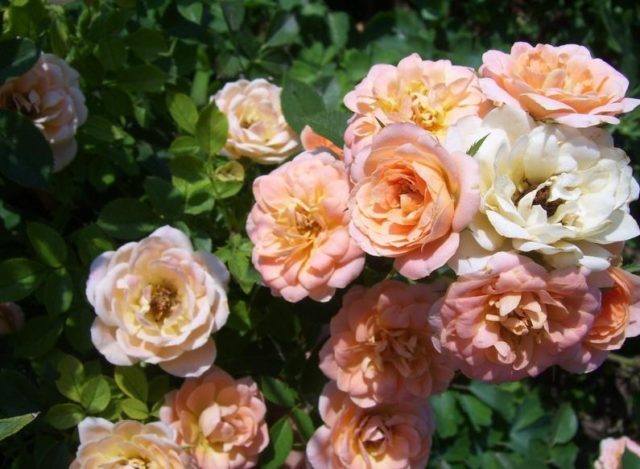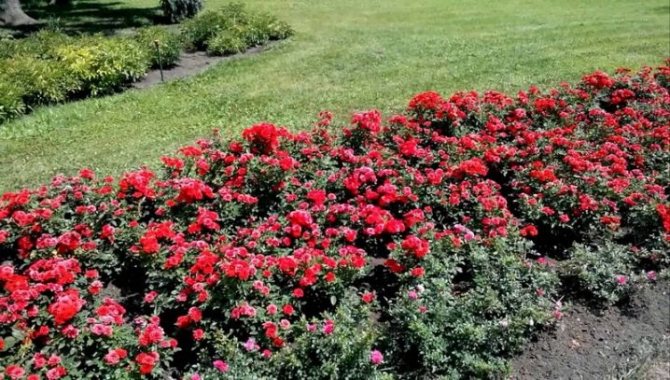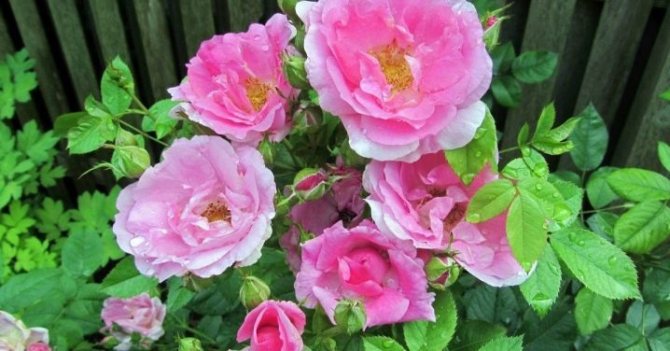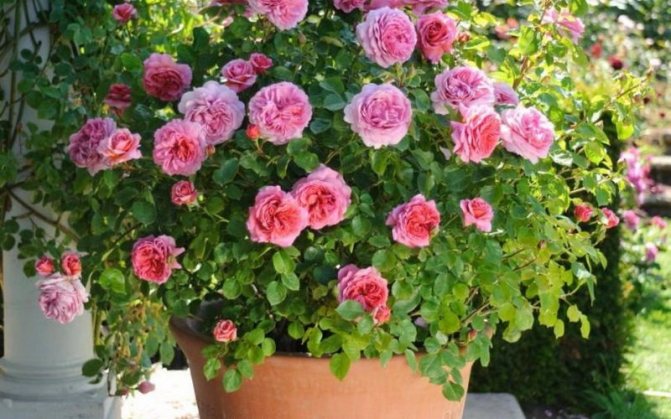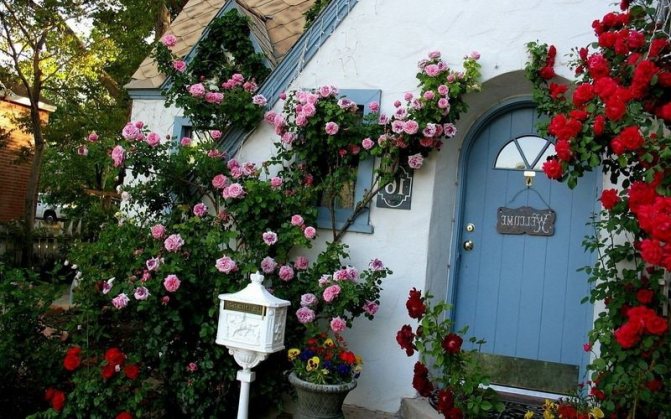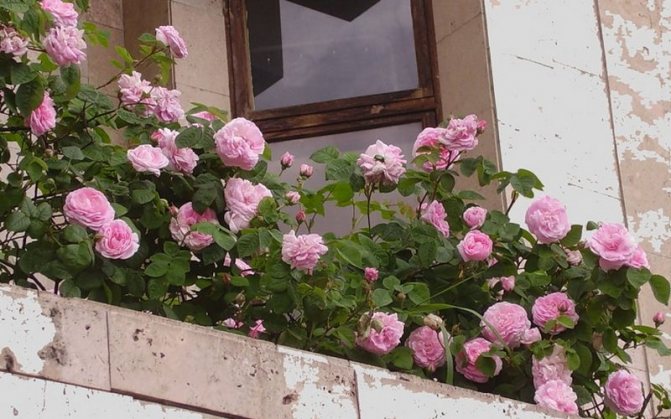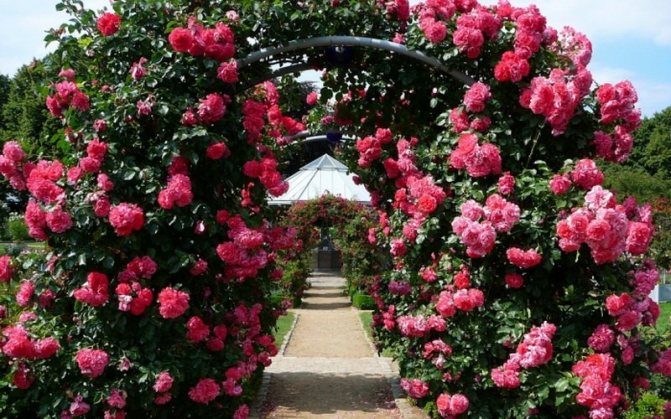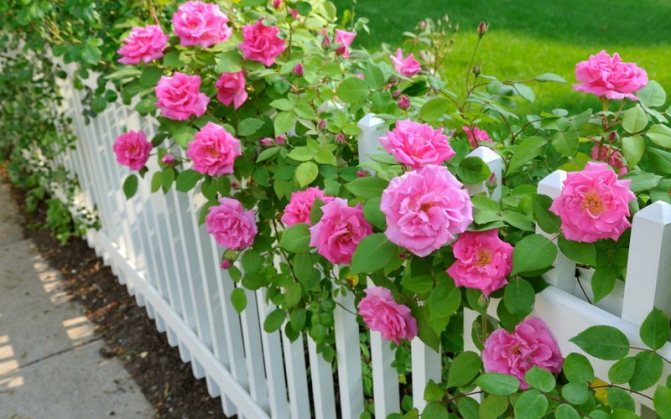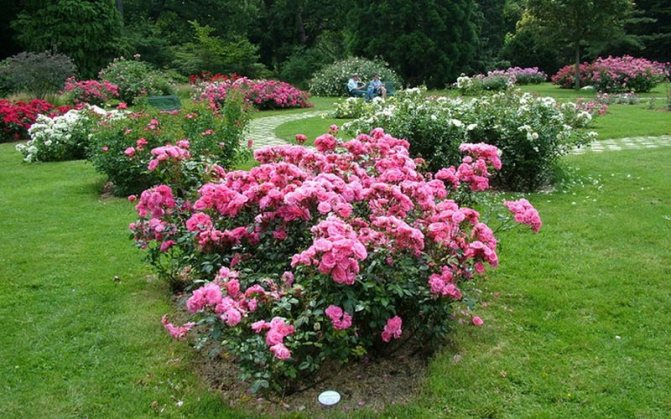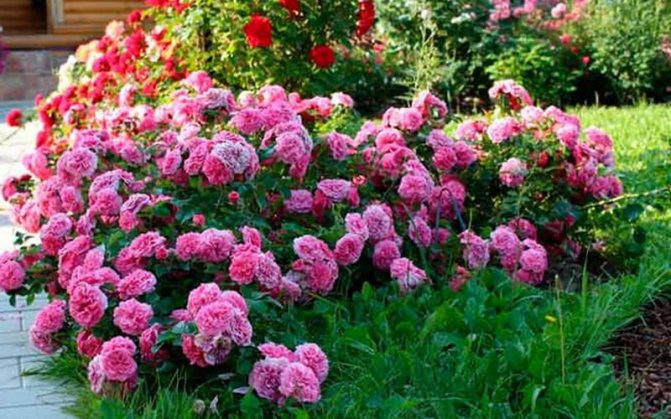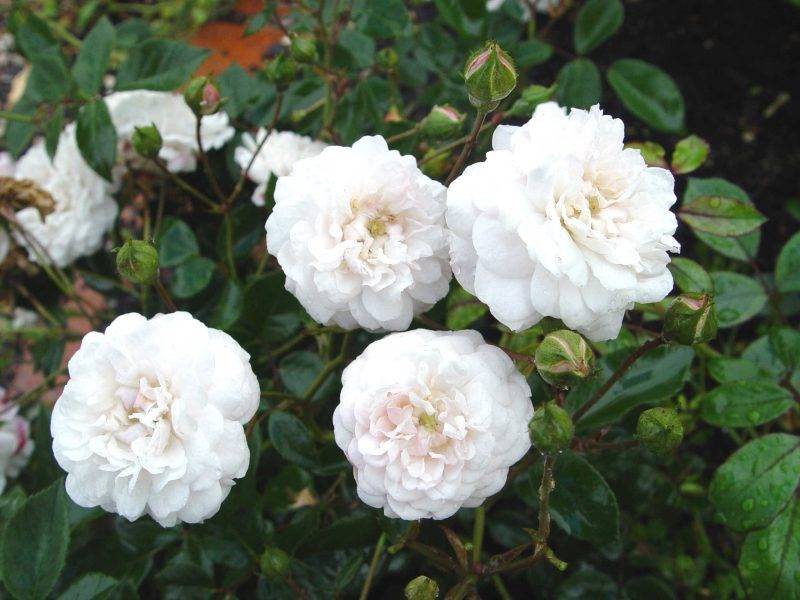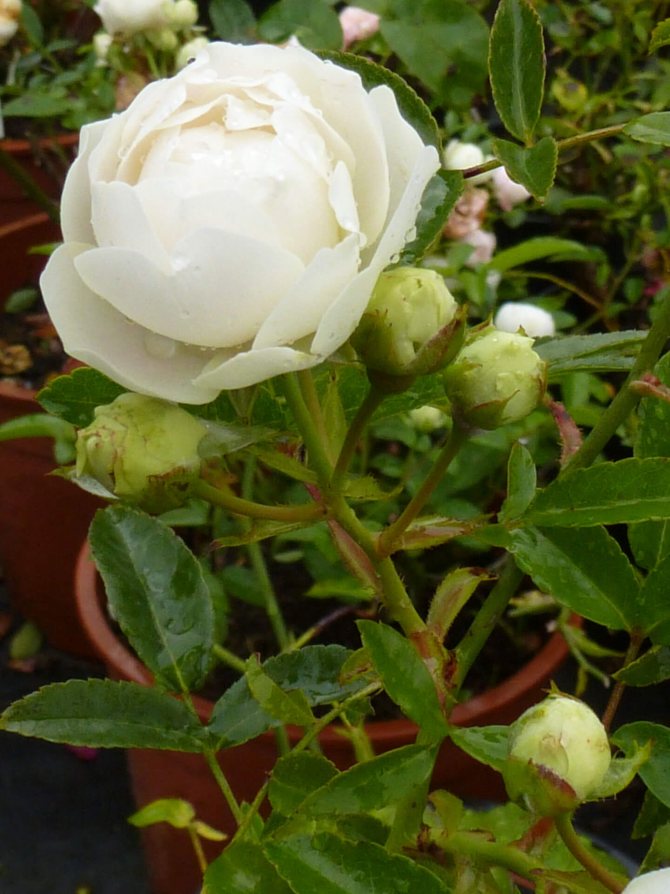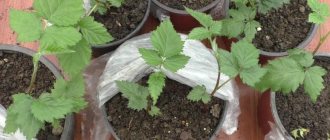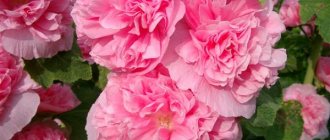Every girl loves roses, and every gardener tries to grow them at home or in the country. They are a great decoration for any site, especially if you choose several varieties of different colors at once. But rarely does any of the gardeners use them as a curb plant.
But botanists distinguish their separate variety - border roses.
It is impossible, of course, to present them as an addition to anything else, we are used to the fact that they themselves are - the center of the picture. Immediately, miniature roses act as an exquisite frame framing the overall landscape of your personal plot.
But in order to maintain such beauty, it takes a lot of effort and know some of the subtleties of working with border roses.
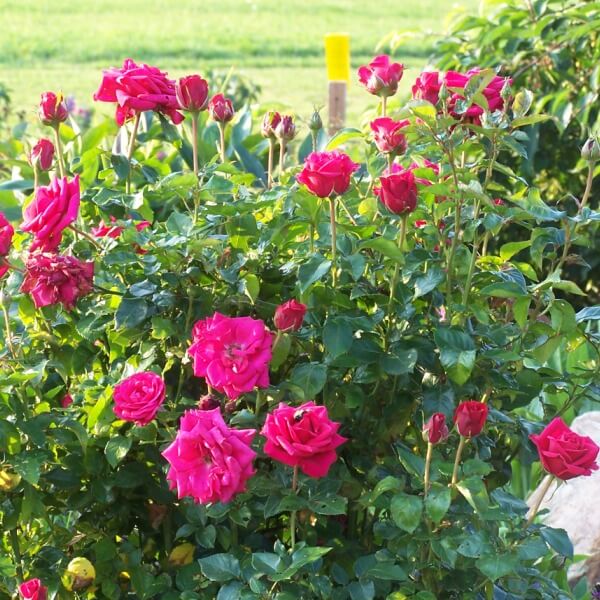
Do you have border roses? How do they look?
A distinctive feature of these roses is abundant flowering, unusual shape and fluffy petals. During the season, they bloom again, take root well under different conditions, are not afraid of frost and belong to unpretentious flowers. These flowers are used to decorate city parks, and now they are in great demand for planting in private garden plots. The curb rose is highly valued by landscape designers for its originality and decorative effect. Such roses are planted in March. All border roses are small in stature, and they are also shrubs that are very easy to care for. These flowers do not require complex technologies for planting and further growth.
Rose petals have a double base, as well as small fluffy bushes that bear fruit over time. You can see 3-4 flowering changes per year.
They can be planted in flower beds, lawns or gardens. There are many different varieties of border roses. Here, as they say, for your taste and color.
A curb rose can also look great in your home on a windowsill, which is well lit and has no draft. This is a wonderful gift for ladies.
If you decide to plant roses at home, then you will not need to insulate them. It is enough just to water and spray the plant from a spray bottle on time.
The curb rose is propagated by both seeds and cuttings. If you are an experienced gardener, then you can work hard with the seeds, and if you are a beginner, it is better to buy a cutting and plant.
Pruning bushes
Since these small roses are always in the foreground in almost any landscape, special attention must be paid to their pruning. Sanitary work is performed regularly, constantly removing dried branches that are sick or damaged by pests.
Pruning to get the correct shape of the bushes should be done as needed, but in the fall, even before the onset of the first frost, so that the injured areas do not rot. A cut is made 5–8 mm from the kidney. Wild growth is removed at the neck level. Only in this case the wild will not grow back.
In young bushes of the first year of life, pinch all the shoots after the 4th and 5th leaves. The buds are removed. The central, vertical stems of the older bushes are not cut, only the lateral ones.
Pruning healthy branches can produce viable cuttings that are planted in prepared soil and covered with a plastic bottle.In the future, they are monitored and looked after in the same way as for cuttings of ordinary roses: they water and carefully weed out growing weeds on time.
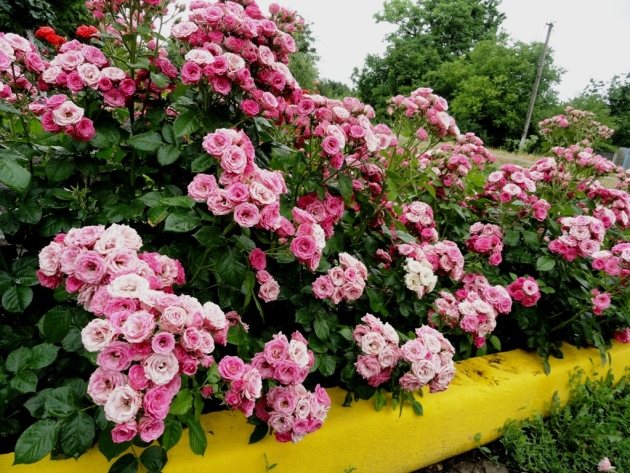

Features of border roses
Curb rose: reproduction and care
For breeding, it is very important to choose a flower bed that is well lit by sunlight. The curb rose loves sunbathing all day long. Also, the saturation of the color of the flower depends on the sun. But with all this, the landing site must be protected from strong winds. It is worth saying that curb roses do not withstand dampness and may deteriorate when planted.
But if you have a poorly lit flower bed, and you really want to plant a border rose, then you will have to work on lighting the flower bed. There are many ways to do this now.
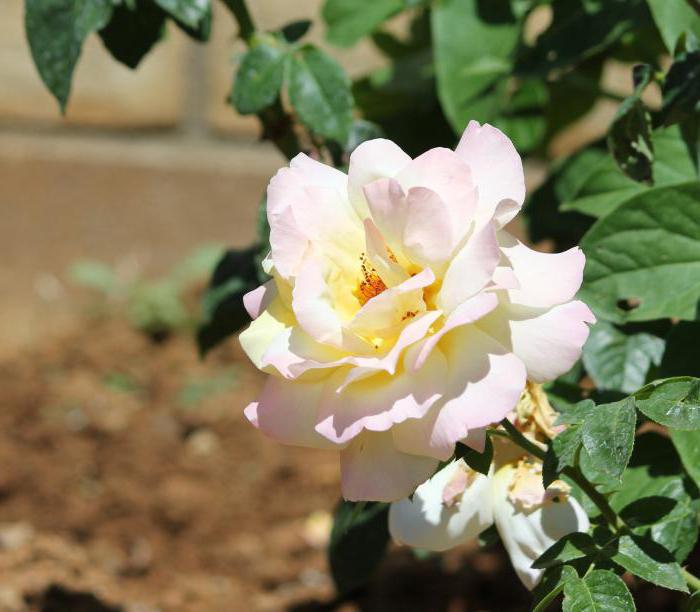

When planting, you must take into account the time of year. It is better to plant roses in early spring so that their root system develops well and gets stronger in the ground. If conditions permit, you can plant it in the fall, and in the spring you can transplant already gorgeous rose bushes.
Do not forget about the elementary loosening of the soil. The curb rose, like other plants, loves him very much.
After planting, it is advisable to organize greenhouse conditions for the rose in order to protect the rose from temporary frosts.
Landing rules
Roses should be planted in a well-lit place protected from the wind. Strong wind gusts take away moisture, its lack is reflected in growth and color. You can not plant a rose in an area where other rosaceae have grown for a long time. In such a land, spores of fungal diseases, viral agents and beetles develop. Border roses are undemanding to an earthy composition. They take root on any soil, except dry, dense and swampy.
Before planting, improve the land by mixing with drainage or organic matter.
It is advisable to land in March, when the ground warms up a little. Then the roses will have time to take root and develop by winter. While the plant is "settling" in a new area, it is better to cover its young bushes. This will protect them from night frost.
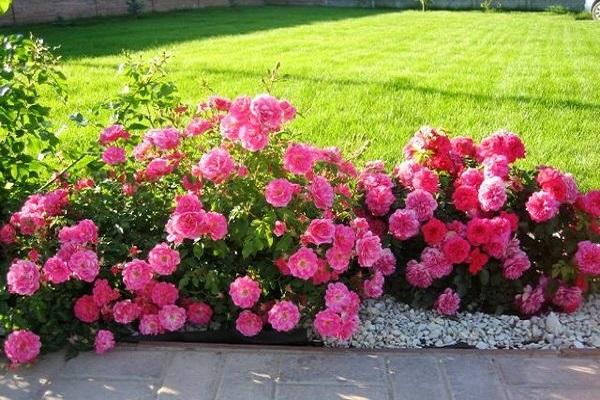

Planting technology for mini roses:
- dig a hole larger than the diameter of the rhizome;
- spread the root system in the hole, deepen the end 3 cm into the ground;
- the distance between the seedlings should be 25 cm.
After planting, compact the soil, water abundantly.
How to insulate a curb rose when planting?
Since the rose is a small plant, insulating it will not be as difficult. When planting for the first time, it is covered with a cut bottle or jar. If you have a greenhouse on the site, then plant a rose there so that it grows stronger and does not freeze.
Just don't forget about watering and caring for it. By the way, an excessive change in weather can affect the cutting for the worse.
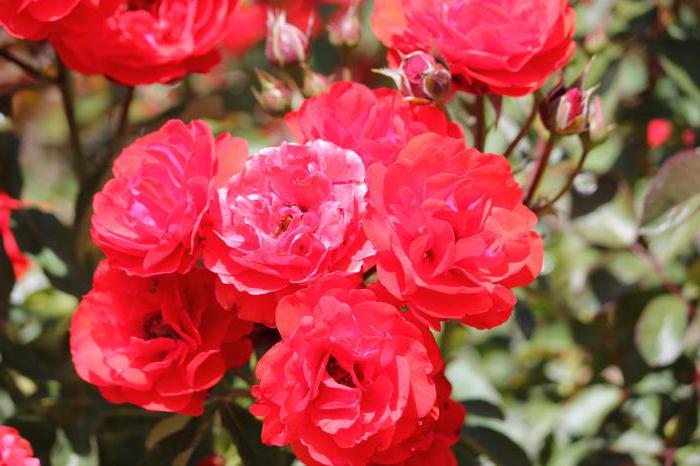

Breeding flowers
Roses are propagated by cuttings, seeds, dividing the shrub. Each method assumes an individual technique. Cuttings are in great demand. Seed propagation is the most affordable method, and dividing the bush is also, but the plant will take longer to form.
| Reproduction method name | Instructions |
| Cuttings | Cut the branches with a sharp knife into separate shoots, so that each has at least 3 buds. Process the seedlings in a manganese solution, keep in it for 20 minutes, then, in a stimulator of the formation of the root system. In the fertilized soil, stick the planting material so that 1 bud is located in the ground, at a slight angle. The cuttings should be spaced 25 centimeters apart. If planting work is carried out on open ground, cover each petiole with a glass jar or transparent plastic container. Water the shoots abundantly without flooding them completely. After 2 months, transplant to a permanent site. In the first winter, cover young bushes with needles, dry grass or leaves. |
| Seeds | Seed breeding of a rose is a more complicated procedure.When selecting them, take into account the shelf life, the tightness of the pack. It is better to start planting work from September until frost, so that the seedling will get stronger by summer. Pre-soak the seeds in warm water, for 7 days, then sow in a prepared container. Seedlings that have reached 8 centimeters are transplanted into pots. Planted in open soil from late May to late June. |
| Bush division | Dividing a shrub is the easiest method for growing roses. In March, they dig in a bush, shake it off the ground. With a sharp, disinfected knife, the rhizome is separated. It is planted in prepared soil. |
Curb roses: care
Rose bushes should look neat and lush, for which it is necessary to prune the plant in time and remove old stems. In this case, after winter, you need to prune the tops of the plant for splendor and growth.
Many rose breeders believe that organic and mineral supplements are essential for flowers. With proper care, you will notice several flowering phases until the most resistant frost, so you need to fertilize several times a year.
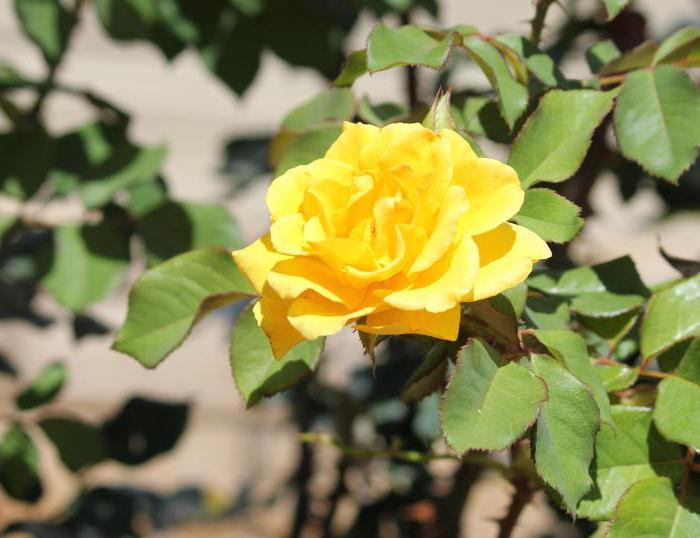

Do not forget that any plants, including roses, can get sick or meet pests. And this is also a reason to rid the flowers of these unpleasant ailments by feeding. Also, the proximity to other plants will help to repel pests or diseases.
Dwarf roses
The birthplace of miniature roses is China. Now breeders have bred more than 100 varieties. All of them are distinguished by beautiful small flowers of various shades that exude a subtle aroma or do not smell at all.
Benefits of dwarf roses for decorating gardens and loggias:
- The bushes are compact, up to 40 centimeters in height, the stems do not fall to the ground.
- Most varieties are frost-resistant, so they are suitable for decorating a flower bed as a perennial.
- Flowering continues from May until frost, old buds are constantly replaced by new ones.
- Flowers are miniature, varied in shape and color.
- Among dwarf roses, there are varieties with both one flower on the stem and many, which allows them to perfectly fit into landscape design.
- Climbing and creeping species of mini roses have long (up to 5 meters) shoots, flowers are small, up to 4 centimeters in diameter, but almost the entire bush is strewn with them. The flowering period depends on the selected variety. This is a great option for creating hedges and arches.
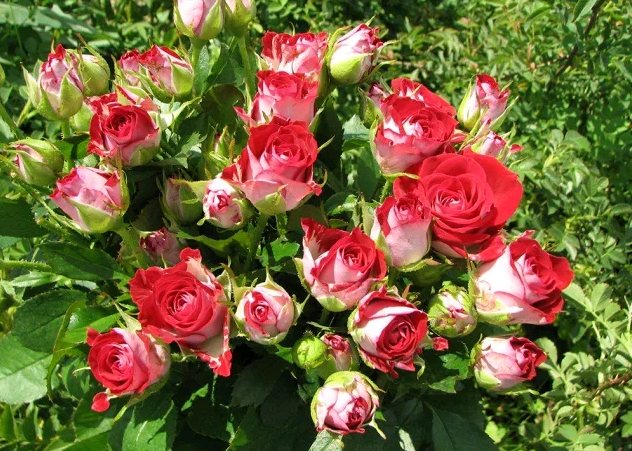

Small roses
Time to feed
- The first feeding is carried out in the spring with fertilizer to strengthen and protect against frost.
- The second is two weeks after the first.
- The third is in mid-June.
- The fourth is in July.
- The fifth is in August.
- The sixth is in mid-September.
- At the end of September, we carry out liming.
All dressings are carried out in turn: first with organic, and then with mineral fertilizers. They can be either purchased or homemade, which everyone has become accustomed to using for a long time. They have long established themselves on the positive side. It is only important to correctly calculate the dose of feeding.
Popular varieties
There is an abundance of border rose varieties to suit all tastes. Each variety has its own characteristics, planting technology, shade range. Gardeners are advised to give preference to the following varieties.
| Cordula | The variety of roses is famous for its light aroma, spherical inflorescences of orange-scarlet color. Flowering occurs throughout the summer. The brushes are large, bright, look great against the background of dark green leaves with a bronze tint. Red roses are often found, but their color can change up to apricot. Shrubs are undersized, branched. The variety is unpretentious in care. |
| Little white | Canadian roses are pale white. Terry flowers, medium in size, not exceeding 5 centimeters in diameter.They gather in small inflorescences of 5 pieces and smell sweet. Bushes reach 80 centimeters high, require pruning and protection from wind gusts. Snow white roses go well with other flowers. |
| Clementine | Bushes are erect, branched, grow up to 50 centimeters. Orange color gives the inflorescences romance. Border roses are capable of changing the shade to peach, it all depends on the level of lighting on the plot. Their advantage is the long period of pollen, all summer. Flowers are regularly renewed on the bushes. |
| Lidia | A subspecies of spray roses. The flower was bred in the Netherlands, it grows up to 70 centimeters. Shrubs grow in width up to 60 cm. The buds are pale pinkish, shimmer in the sun from a deep raspberry to light pinkish hue. The culture is frost-resistant, famous for its strong immunity to diseases and beetles. |
| Yellow doll | The most popular type of border roses, characterized by a neat appearance, diminutiveness. Spreading shrub, grows in length up to 25 centimeters. Flowering occurs throughout the summer. Inflorescences are yellow, 6-7 centimeters in diameter. The variety is grown both in pots and in gardens. |
| Sugar Baby | A miniature variety of lemon-colored roses gradually turning into bright scarlet or light pink. The shrub grows up to 40 centimeters high, does not grow. Flowers tolerate wintering well, bloom all summer. Up to 15 small inflorescences are collected in one bud. It is desirable to grow the variety together with other mini-roses. |
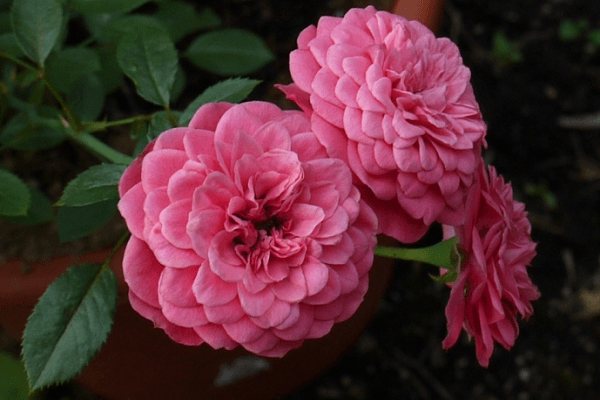

The listed varieties of border flowers of the Rosaceae family will become the highlight of the garden, they will be thanked with long flowering with proper care.
Propagation by cuttings
Reproduction begins in May and continues through June. Roses form shoots with young buds, which must be cut in half to obtain 2-3 buds.
Before planting the cuttings, you need to soak the buds in root growth solutions. Now there are a lot of them on sale. You can also use folk methods. For example, use a weak manganese solution. To do this, prepare a solution, put the kidneys in a glass and observe. Roots will begin to grow in two days.
Then, border roses are planted in a hole, preferably fertilized with sand and humus, under a slight slope. The distance between the flowers should be at least 18–32 cm. When planting, the remaining leaves fall off over time, and new ones grow in their place.
If you come across a stalk with a bud, then you need to pinch it, since the bud will take all the strength from the bud and will not allow the root to grow.
Also, young bushes are watered and covered with a cut bottle to arrange greenhouse conditions.
Two months after planting, you can dig up a sprouted rose bush and plant it in a permanent place. In this case, you should actively water and spray the plant, which will improve the quality and habituation of the flower in the soil.
Landing in open ground
In order for rose bushes to look elegant and healthy for a long time, you need to properly organize their planting. These small plants are quite unpretentious and not particularly demanding on the properties of the soil. It is enough that it is not swampy and not too heavy. True, small roses also dislike overdried soil, since their roots are located close to the surface, and react sharply to a lack of moisture. There are the following rules for planting border roses:
- You can plant roses after the threat of spring frosts has passed, and the soil is well warmed up. This will facilitate rapid establishment and adaptation.
- It is necessary to dig a hole of sufficient depth, where the roots can freely fit, the length of which can be more than 30 cm.The depth of the hole should be at least 40 cm, and the diameter may be larger, since you will have to add humus, or even better - special soil for roses. Drainage should be placed on the bottom - gravel or small pieces of brick.
- The roots of the plant during planting must be well spread, the root collar must be immersed in the soil by about 4 cm.
- The soil around the plant is compacted and watered well.
Long roses
The planting scheme should be such that a distance of at least 30 cm remains between the seedlings.But if it is assumed that the bushes will be rather spreading, you can leave 50 cm.
Note! After planting, rose bushes need to be covered if the air temperature can drop significantly.
What to look for when buying seeds
- When buying seeds, the main thing is not to make a mistake. You need to look very closely at the expiration date. Buy seeds that are not expired because they may be empty.
- Pay attention to the color of the rose: whether it will suit your flower bed or alpine slide, what shade you combine with other plants, whether it will not look ugly against the background of other roses.
- It is worth carefully studying the longitude of flowering, because it is varied in different varieties. You should also know early flowering or late.
- You should definitely study the planting and grooming requirements, as they may differ in some way. And this must be taken into account immediately so that later there will be no oversights.
- Buy seeds in specialized stores so that later it turns out that instead of beautiful, shaggy border roses, you got a rose hip. In them, such an oversight is not allowed.
- The planting time is also worth considering, as it may require a special growing area, light and humidity.
There are many factors to consider when planting. You need to germinate the seeds, plant them as seedlings in pots and then wait for the shoots to germinate, and then carry out the usual transplanting.
Roses border varieties are very diverse. Let's consider some of them.
Description
The curb rose is a miniature bush variety. Shrubs grow 60 centimeters high, compact, laconically frame the plot with a romantic border. The petals are famous for their terry base and a variety of colors. The buds can be monochrome, or combine several colors.
There are varieties in which the inflorescences change color more than once a season. The Masquerade variety is distinguished by its bright yellow, turning into a pinkish color, and in the fall the flowers become rich crimson. Border roses are picky to care for, easily survive transplants, frost-resistant. Their peculiarity is the possibility of cultivation in the garden and on the windowsill in a pot.
Garnet bracelet
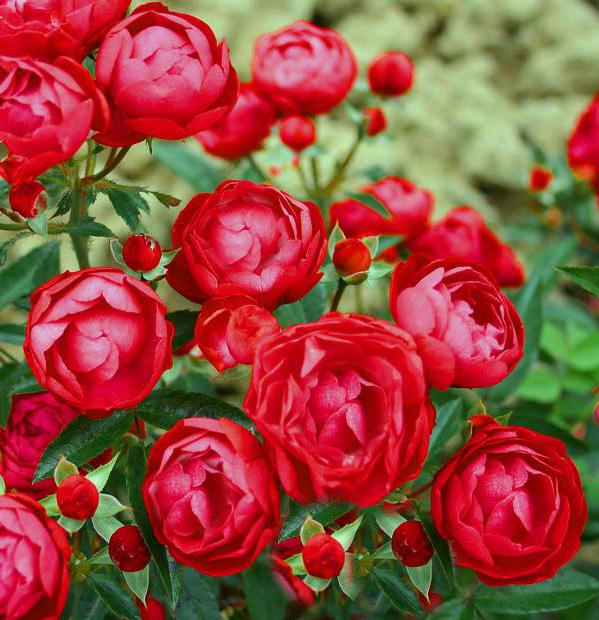

The variety got its name due to its bright red color, beautiful thick double petals, and also under the influence of the story of the writer Kuprin.
The flowering of this variety is continuous until autumn. The plant is of medium size, frost-resistant, well resistant to diseases, as it has immunity to them. Rose Garnet bracelet is not particularly demanding to care and tolerates long sunny weather.
Growing
Caring for curb roses is not particularly difficult, so even novice summer residents can cope with it. In order for the rose to thank the gardener with lush flowering and healthy growth, it should be watered periodically, cut off the shoots and feed the roots with minerals. The areas where the flowers grow should not be too moist or dry. Watering should be done in the evening, using pre-settled and heated water. You can not use irrigation of the aboveground part of the flowers, you can water only at the root.
Read also: Complex hot vegetable dishes
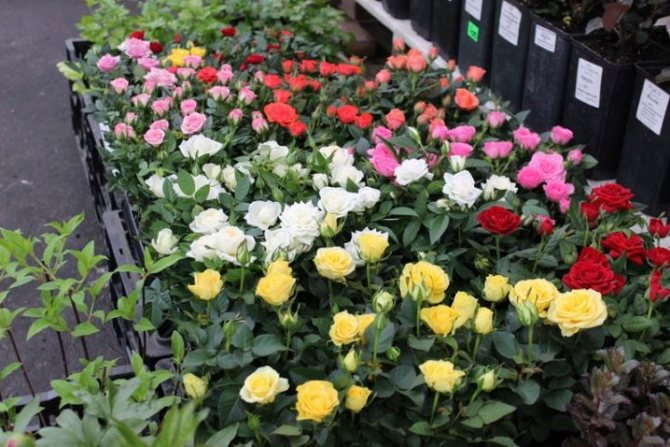

Caring for decorative flowers also provides for timely feeding, which should be carried out 2-3 times per season. As fertilizers, it is allowed to use mixtures intended specifically for decorative flowers, "Kornevin".Additionally, you can use organic matter in the form of horse manure, but you need to be extremely careful with it in order to prevent burns of the rhizomes.
The cultivation of such roses is not complete without pruning. At the same time, these crops must be able to properly crop. The procedure is the cleaning of the bushes from dry and diseased shoots, during which a beautiful and neat ground part is formed. The cut off area of the shoot can be affected by viral diseases and rot. To prevent this, you should always use only clean garden tools. Pruning must be done throughout the summer.
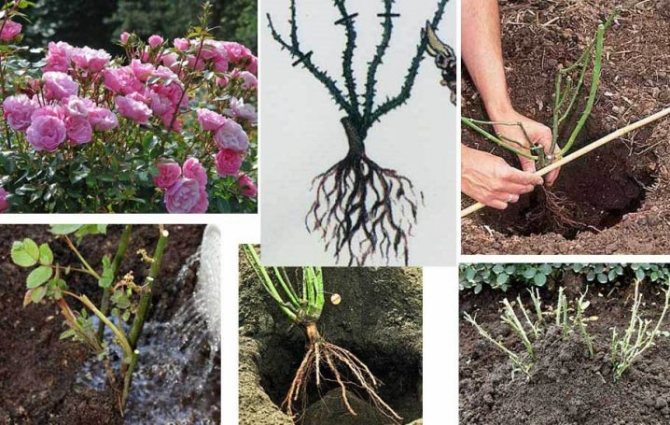

If you take care of the plants correctly, they will turn into gorgeous bushes by the fall. They can be propagated both by cuttings and seedlings.
Masquerade
The variety got its name from the color change. The second name of the rose is Chameleon.
The color changes depending on the season: from a bright yellow color, it turns to pale pink and at the end it acquires a dark crimson. The color of the leaves is dark green, fine structure. The flower blooms profusely and beautifully, has a fruity scent, is well resistant to diseases and pests, frost-resistant and resistant to rain. Rose Masquerade on any flower bed will look impressive even on its own.
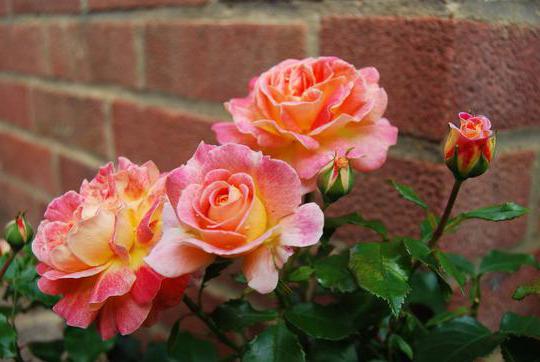

But the variety has special care requirements. After flowering and drying of the buds, they must be cut off for further flowering. With proper care, the rose blooms continuously.
Care and feeding
Caring for and growing curb roses is not burdensome. Even meeting the minimum requirements for providing the plants with favorable conditions gets a quick return - they grow healthy and bloom beautifully.
Musk roses
Water roses at the root, it is better to do this in the evening. During the day, the water is heated in the sun and does not stress the plant.
They feed the bushes several times throughout the season. Fertilizers are usually used for flowering ornamental plants or directly for roses. If possible, organic fertilizers are used, rotted manure is suitable, horse manure is best. It is thoroughly mixed with the soil and laid out under the bushes. Ripe compost can be applied in spring and autumn. For 1 m², it will need at least 5 kg. When buds appear, roses are watered with calcium nitrate (one tablespoon for 8-10 liters). So that the plant does not get burned, it is pre-watered, and after feeding, watering is repeated again. For full nutrition of the bushes, depending on their condition, every 20 days, you can feed them with organic and inorganic fertilizers, herbal infusions.
Important! Young roses need feeding only in spring and autumn. In September, the soil is limed.
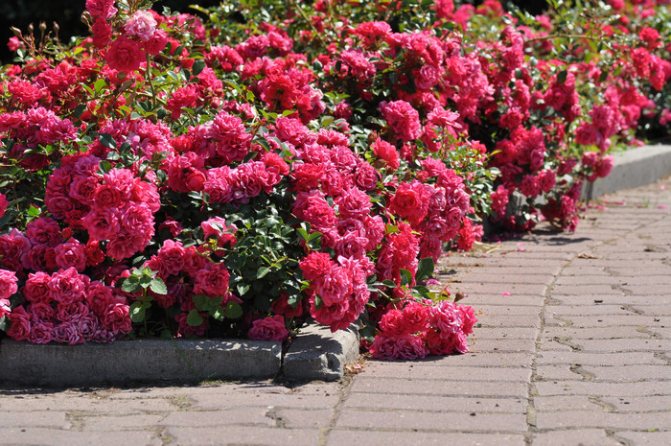

What you need to know about curb rose
Curb roses: description, cultivation and varieties for open ground
The curb rose is a highly decorative culture with a height of 50-60 cm, which is able to transform and decorate any area. Landscape designers love this plant very much for its individual characteristics and a lot of advantages over other representatives of the flora, and border roses have a lot of positive qualities:
- they are unpretentious in care and cultivation;
- very quickly take root in a new place;
- most of the varieties have a high level of frost resistance;
- perfectly tolerate high air temperatures in the summer season;
- grow well and develop not only in the garden area, but also as a houseplant (in flower pots);
- used in single and group landings;
- there are many varieties and shades during flowering;
- many varieties are capable of blooming twice a season;
- have a long and abundant flowering period.
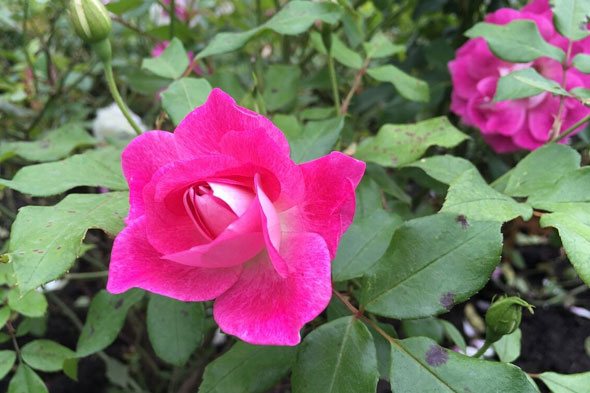

Diseases and pests
Any plants, including the curb rose, can be attacked by insects and get sick.
Neighborhood with many species of plants can prevent the appearance of insect pests.If roses are planted next to marigolds, sage or onions, they will never have caterpillars, aphids, sawflies, spider mites.
In order to prevent and with a single lesion, rose bushes can be sprayed with infusions of onions, yarrow, garlic, calendula, and sprinkle the ground around them with ash. If pests nevertheless appeared en masse, you should not immediately run for chemicals. Try natural, less harsh remedies first.
Dissolve laundry soap in 10 liters of hot water and add a few branches of wormwood, mix, boil for 15 minutes. After the solution has cooled, mix everything again, strain and spray the bushes.
If after treatment the pests have not died, re-spraying can be repeated after 5-7 days.
When natural remedies fail and insects are spreading, insecticides can be used:
- against spider mites - "Sunmight";
- against aphids, caterpillars and sawfly - "Mospilan", BI-58, "Aktofit", "Aktara".
Miniature roses are highly susceptible to diseases:
- powdery mildew;
- black spot;
- rust;
- alteriosis.
It is easy to prevent their appearance. It is enough to spray the culture with solutions of copper sulfate (3%), DNOC (1-3%) or nitrophenol (2%) before sheltering the culture for the winter and after opening.
If an infection has occurred, then the following means are used in the treatment.
- Water-soluble sulfur (1%), Bordeaux mixture (1%) are effective against powdery mildew.
- Copper oxychloride (0.2%), Bordeaux (1%) mixture will help get rid of black spot.
- Rust can be cured with water-soluble sulfur (1%) and copper oxychloride (0.2%).
- Spraying with foundation (0.2%) or copper oxychloride (0.4%) will help to cure an infectious leaf burn.
Some fungal diseases (for example, powdery mildew) appear if care and planting conditions have been violated: bushes are planted close to each other, abundant watering.
When caring for a plant, it is important to regularly examine each one, pick off “suspicious” leaves and burn them, cut off dry branches in a timely manner so that diseases or pests from one infected plant do not pass to neighboring ones.
Treatment brings a quick and effective result if it was started at an early stage of the disease, when the lesion was single.
Read also: What to give to calves for fast growth
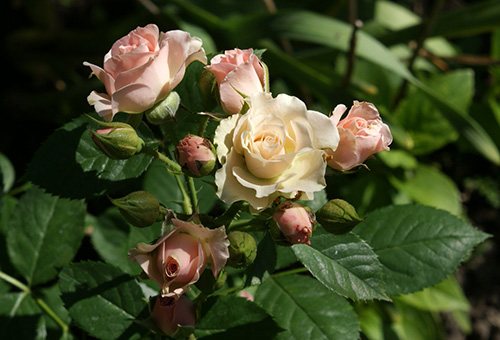

Pruning
In the spring, immediately after removing the covering material, the rose is cut off. Broken, sick, shoots that have not survived the winter are removed. After that, they move on to formative pruning. The bush is thinned out. The twigs growing inside the rose are removed, the shoots are shortened. At least three buds are left on the stem. Cut to the outward-facing kidney at a 45-degree angle. Sections are powdered with crushed charcoal.
In the summer, wilted flowers are removed. Moreover, they are cut off, capturing three centimeters of the stem. Then dormant buds will awaken, and buds will appear faster from them. This will maintain the continuous flowering of the bush. Dried twigs are cut out, yellowed leaves are plucked.
In the fall, diseased and dried shoots are removed. And others are shortened so that you can cover well. It is not necessary to cut too much. The main pruning is done in the spring - then you can see in what condition the shoots came out of winter.
Wintering
Successful overwintering of a rose depends on its readiness for winter and shelter. Preparing a rose for winter includes:
- exclusion of nitrogen fertilizers from top dressing;
- application of phosphorus-potassium fertilizers in August-September;
- cessation of watering.
In September, you need to pinch the shoots, and after the first frost, remove the weak, fragile stems. The bushes are spud up to a height of 15 cm. When the temperature drops to minus seven degrees, spruce or pine spruce branches are thrown onto the rose bush. Arcs are placed over them. A non-woven material is placed on top, which is fixed with any available material.
The size of miniature roses allows you to take them to the house for wintering. It is very convenient to do this if the rose is planted in a pot. The pot is taken so that the roots are free there for a year.Expanded clay is placed at the bottom, and it is filled with a special soil mixture for roses.
Examples in landscape design
Border mini-roses fit perfectly into the landscape design of any personal plot. Due to their compactness, bright colors and sophistication, they are perfectly combined with various garden plants. These colors can be used to decorate borders of various shapes and designs. Compositions of rose bushes planted near stairs, paths, recreation areas and "dry streams" look beautiful. To get an interesting effect, roses should be combined with other vibrant flowers and herbaceous perennials. Combinations of roses with dwarf barberries, Japanese spirea and lingonberry bushes will help to emphasize the beauty of flowers.
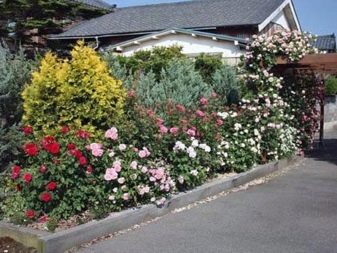

When decorating a site, it is important to consider that red roses should not be placed next to orange, purple and pink flowers. If a flower border is installed along a garden path, it can be filled with combinations of white with blue, red with lilac, yellow with purple. It is best to use flowers of the same variety for design. Such compositions can be made horizontal, or they can be placed in flower beds lined with natural stone. In the spring, planting snowdrops, hulls and muscari will help dilute the juicy colors.
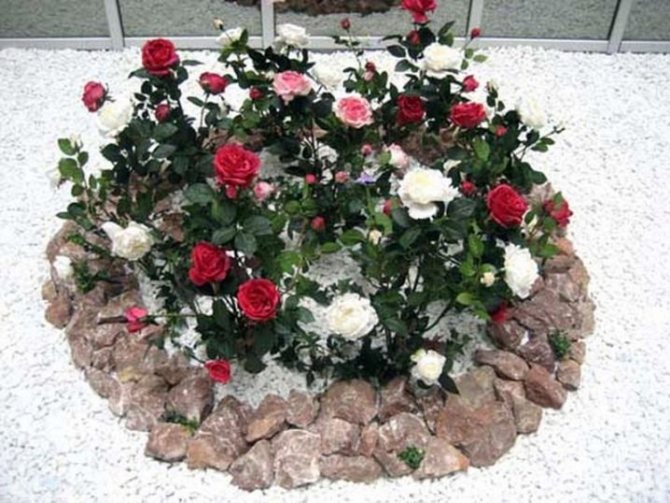

If a lot of shrubs are planted on the personal plot, they can be supplemented with flower beds of roses. They will look win-win against the background of spruce, thuja, cotoneaster and magnolia. To avoid clumsy design, bushes and plants should be placed at a distance of 1 meter. The courtyard fences look great, near which are planted rose bushes and lilacs, chubushnik, yellow acacia. This combination of the palette gives the site an unusual look.
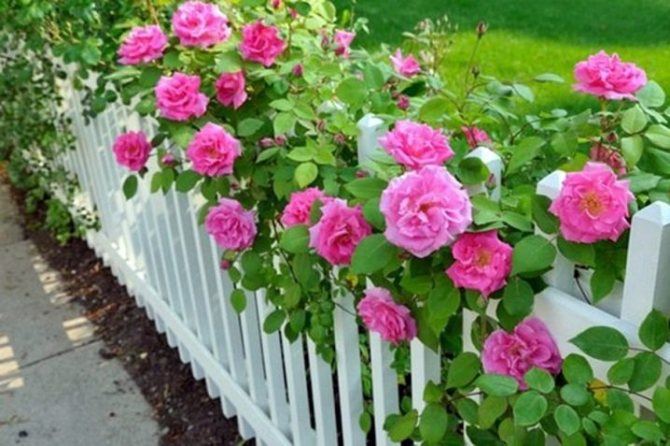

For spacious summer cottages equipped with a seating area, one- and two-sided curbs will be an excellent solution. At the same time, roses can be combined with other varieties, correctly selecting the height of the stems, the size of the buds and the shade. The most popular are the curb paths 80 cm high. They are arranged in two rows, using white, yellow, pink and purple roses.
For information on how to plant border roses, see the next video.
It is impossible to convey in words those feelings and emotions that appear at the sight of these amazing flowers. Correctly carried out planting of a curb rose and subsequent high-quality care will allow you to enjoy its delicate aroma and fragrant appearance in the garden for a long time.
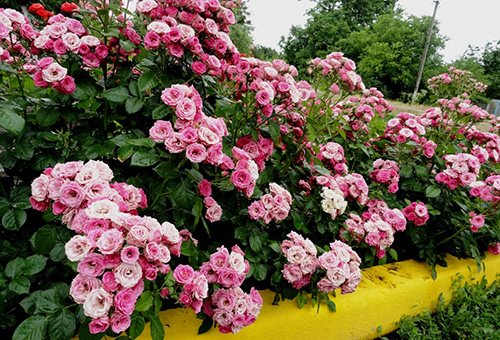

Classification
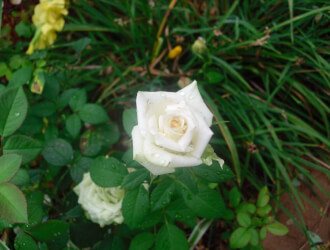

Miniature (different)
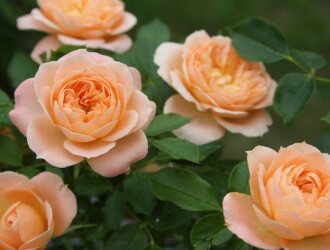

Miniflora
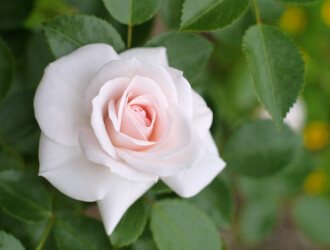

Patio
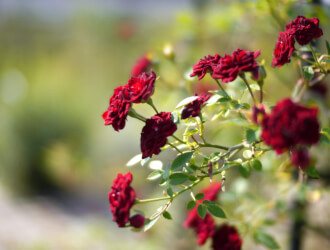

Climbing miniature
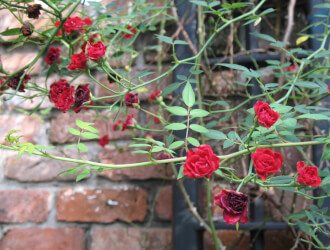

Wicker Patio
How should you care for a flower garden?
Caring for a curb rose will not cause difficulties even for those who are engaged in its cultivation for the first time. If the basic requirements for pruning, watering, feeding are met, the plant will thank you with good growth and lush flowering.
Watering
Miniature roses need regular, but not abundant irrigation. Drying and waterlogging of the earth must not be allowed. Watering is best done in the evening using sun-warmed and settled water.
Do not allow water to enter the aerial part of the plant. It should be watered at the root!
Top dressing
Growing roses is not complete without feeding. It is necessary to feed miniature plants several times. To do this, you must use fertilizers designed specifically for Rosaceae or other ornamental flowering plants. You can use organic matter: horse manure. It mixes with the soil and fits under the bushes. It is not necessary to use other manure, as the roots may burn.
Spring and autumn composting works well on miniature roses. It is laid out under the bushes at the rate of 5-6 kg per m2.
When the first buds form, the plant can be fed with calcium nitrate (1 tablespoon per bucket of water). This fertilizer has its own peculiarities of use:
- before feeding, the roses should be well watered so as not to burn them;
- after feeding - water again;
- the time of the procedure is in the morning or in the evening (when the heat subsides).
Additionally, every 15-20 days, you can feed it with mullein, mineral fertilizers or herbal infusions. Liming is necessary in September.
In hot, dry summers, top dressing is rare, in rainy summers - frequent and abundant. Young plants in the 1st year after planting are fed only in spring and autumn.
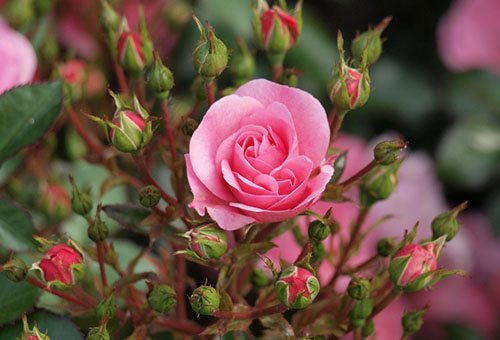

Leaving on hot days
Miniature roses do not tolerate rainy and very hot weather. It causes stress in them. During this period, reanimation agents will help to "cheer up" the plants: "Zircon", "Epin", "Ecosil", potassium humate.
It is important to protect the culture from overheating. A rise in temperature above 25 ºC leads to overheating of the roots and deterioration of the condition of the roses. Peat and hay laid under the bushes will help to cool them a little.
Pruning
Leaving includes another important point - competent pruning. It consists in removing damaged and dry shoots, in the formation of a beautiful and correct aerial part.
To prevent decay and rapid damage to cut diseases, a clean and sharp pruner should be used when cutting.
Pruning is done 5-8 mm higher from the healthy kidney. This procedure can be carried out all season. In the last pruning, extended new shoots and buds are shortened.
If the shoot is damaged, it is cut from above between 2-3 leaves. It is important to cut wild growth from grafted roses. Eliminating the "wild" above ground level will not give any result - it will grow again. Correct pruning is the removal of wild shoots from the very base (from the root collar).
In order for the bushes to grow proportionally, in the 1st year of their life it is necessary to pinch all the shoots that appear after 4 and 5 leaves, remove the buds. In "old" bushes, the central shoots growing vertically are not trimmed, only the lateral ones are trimmed a little.
Preparing for winter
Despite the fact that many varieties of border roses can withstand frost, they must be insulated for the winter. But first, all shoots and fallen leaves are removed. The first night frosts are a signal for the start of insulation. The sequence is as follows:
- to spud the plant, and the height of the embankment should not be less than 20 cm;
- put spruce or pine branches around;
- on them, gently pressing against the soil, lay the shoots;
- cover with dry leaves or spruce branches on top.
Many gardeners make a frame for insulating roses and cover it with a moisture-repellent material (roofing felt, insulating paper) folded in several layers. A plastic wrap is additionally laid on top. As soon as the thaw begins in the spring, the flowers can be opened slightly.
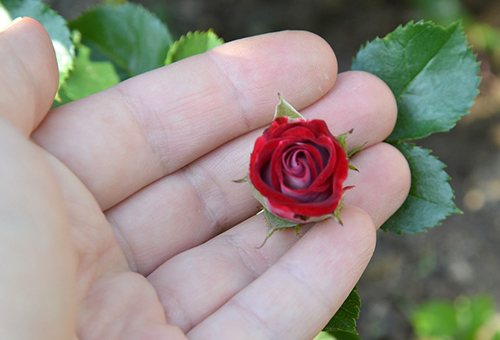

Growing conditions
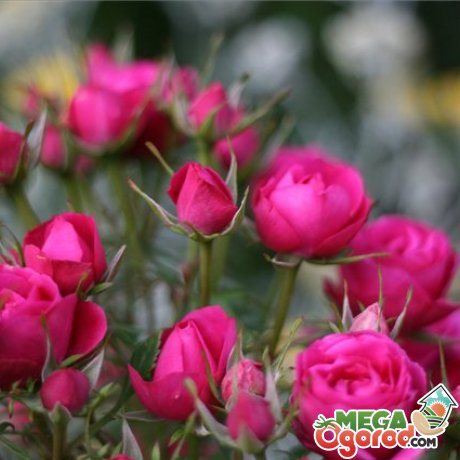

A spectacular plant, despite its general unpretentiousness, requires good lighting. When planting in open ground, it is better to choose a sunny area that is well ventilated. The dwarf rose does not like abundant moisture and dew. This condition always provokes the appearance of fungus and mites.
The best place for a baby rose will be a hill on the south side of the garden.
The plant must be planted so that the harsh north wind does not disturb it. On the north side, you can enclose roses with decorative plantings. It is not recommended to grow roses in too shaded and damp places. The site must be ventilated.
Growing soil:
- In terms of soil, a dwarf rose thrives in regular garden soil. However, it is preferable to grow the plant in soils rich in clay and sand with little or no acidity.
- Dry, sandy soils are not suitable for dwarf roses. If there is only such soil, then it must be fertilized with humus and clay (2 buckets of clay x 2 buckets of humus x each m?).
- Damp soil is drained and enriched with sand and humus in the same proportions.
- Ordinary garden soil is treated with complex mineral fertilizers.
- Try to plant the rose in clay and well-ventilated areas, where the sun will illuminate the plant from morning to evening.
Planting in the ground is usually done in May, sometimes in April. The planting of a rose depends on its variety. Most types of dwarf roses are not afraid of frost. Therefore, they can be planted earlier. Many people plant roses directly in pots, if they do not plan to leave them in the ground for the winter. When fully planted without a pot, the plant is sunk in the soil shallowly - 3-4 cm. The distance between the bushes should be 20-30 cm, depending on the variety. It is recommended to cover the rose at first with a non-woven material. It must adapt to the sun and soil.
Popular varieties
Miniature roses have more than a hundred varieties of different shades. The most popular in the Moscow region are the following:
- Bonika 82 (pale pink);
- Danica (snow-white);
- Garnetfroyde (crimson red);
- Magic Madiland (purple);
- Medeo (white, flowers are not double);
- Sunny Rose (light yellow).
For indoor cultivation, groups of dwarf roses of the Palace series (polyanthus roses with large double flowers), Victory (the height of the bush is only 18-20 cm, and the diameter of the flower is up to 8 cm), Pagoda (ampelous rose with a bouquet type of flowering and apple scent) are suitable.
Choosing healthy seedlings when buying


In order for the queen of flowers to take root and decorate the garden with lush inflorescences, you should use the following recommendations when buying planting material:
- It is important to first decide on the variety, having studied its frost resistance, soil requirements, moisture and other characteristics.
- Buy quality seedlings should be at specialized points, where consultants can provide all the information of interest.
- When purchasing grafted roses, you need to find out on which rootstock the graft was made, since frost resistance will largely depend on this.
- It is better to choose three-year-old seedlings that have had enough time to develop the root system.
- The planting material must have 3 developed shoots, live roots and dormant buds.
Possible diseases
Like any other flowers, border roses are sometimes subject to disease and pest attacks. To prevent the appearance of insects, it is recommended to plant flowers next to onions, sage and marigolds. Thanks to this, spider mites, aphids, sawflies and caterpillars will never appear on them. In addition, it is necessary to periodically carry out preventive treatment of the bushes with infusions of garlic, onions and calendula. In case of mass appearance of pests, chemical agents such as "Aktara", "Sunmight", "BI-58" should be used.
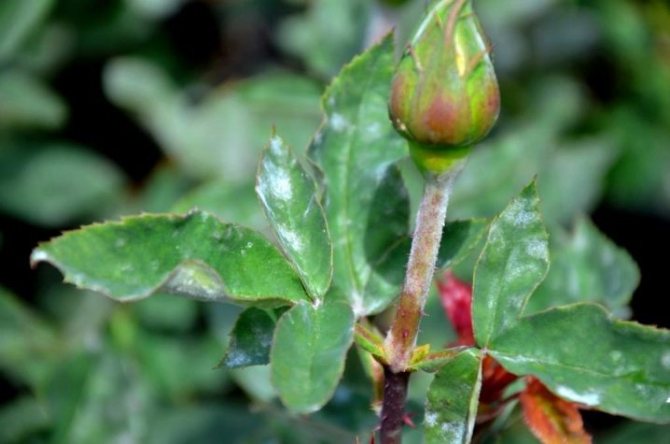

As for diseases, miniature roses are most often susceptible to black spot, powdery mildew, alteriosis and rust. To protect the culture from the above diseases will help its treatment with a solution of copper sulfate, nitrophenol and DNOC, which is carried out both before the bushes are sheltered for the winter, and after they are opened. Moderate watering will help to avoid many fungal diseases.
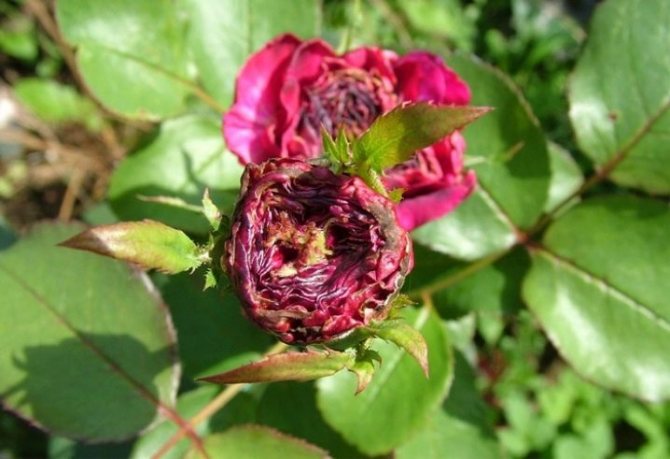

If the culture is still sick, then experts recommend processing with Bordeaux mixture, foundation and copper oxychloride. The affected areas of the plant are cut and burned.
Indoor rose varieties
Mini rose variety Green Ice
A very interesting variety that changes the color of the flower. When the flower has just blossomed, its outer petals are pink, then the flower turns white, then it becomes greenish. It blooms in spring and summer.
Bourbon rose
This variety is not quite mini, its bush for a houseplant is quite large. The color can be pale pink, cream and red. It begins to bloom after May 9 and can remain blooming until the new year.
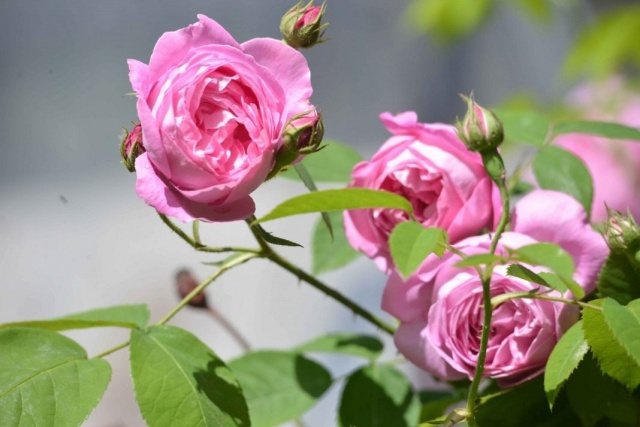

Disadvantage: poorly rooted. Cuttings for planting must be held in the root, it is better to do this in the spring. In March, the bush loses its leaves, this is normal for this variety.Following this, the bush will give many young twigs and will delight with flowering.
Tea rose
Its bushes are decorated with large leaves, there are many thorns not only on the trunks, but also on the back of the leaf. Terry flowers, can have different colors, are unusually fragrant.
Chinese indoor mini roses
Miniature roses are native to China, and the smallest varieties are called Chinese. Their flowers are no more than two centimeters in diameter, and the bushes do not grow higher than 15 cm. There are a lot of varieties united by the name "Chinese".
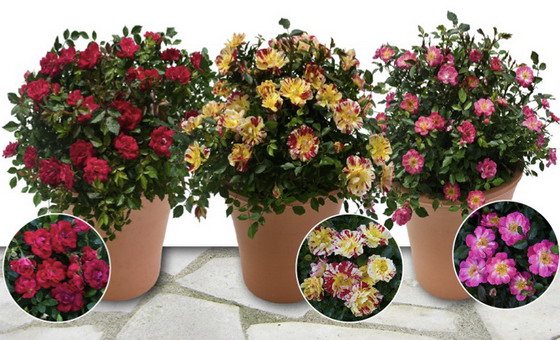

They differ from each other not only in the color of the flowers, but also in their shape, the presence of aroma, and the color of the leaves from dark green to light silver. Most Chinese mini rose varieties require a cold wintering.
Preparing for winter
Despite the frost resistance, the curb rose takes refuge in the garden. In autumn, bare shoots are shortened, and foliage is burned. After the first frost, the bushes spud up to 20 cm in height, after which they are covered with spruce branches, which well protect the flowers from the cold.
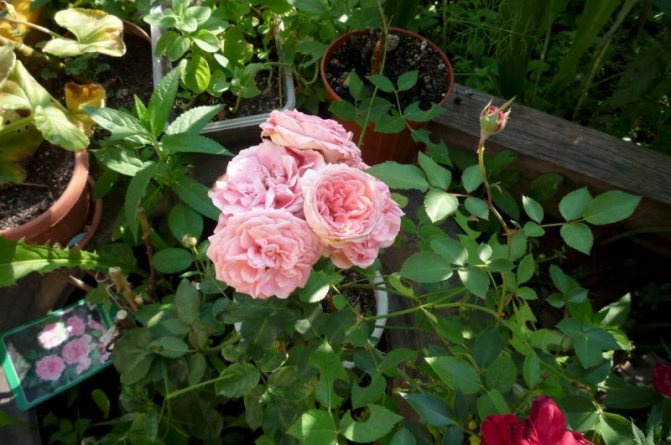

Border varieties of roses can be attacked by spider mites, aphids, sawflies. The most effective and fastest way to get rid of pests is insecticides, which can be used for preventive treatment in early spring. The most common diseases are powdery mildew and rust, which peak in wet weather. To cure the affected plants, the diseased parts of the shoots should be removed, and the plantings should be sprayed with a fungicide.
Growing and caring for potted flowers
Landing
Landing is carried out according to the following rules:
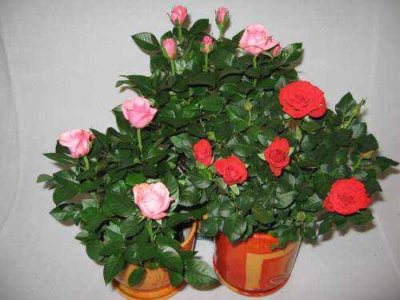

- Prepare a container.
- If the container has already been used, clean it with a brush, do not use detergents.
- Good drainage needs to be done. To do this, you can use expanded clay: if there is a hole in the pot, the layer of expanded clay should not be more than 1 cm, if there are no holes, then at least 3 cm.
- The earth must be used nutritious and breathable. You can buy soil in the store or prepare it yourself by mixing turf, humus and sand in a 4: 4: 1 ratio.
Watering
In the summer, the rose needs abundant and regular watering. Do not let the earth dry out. But if the summer is cold, then do not overfill the plant, for it an excess of moisture is worse than a lack of it. After the end of flowering, watering must be stopped. During the wintering period, watering a dwarf rose is necessary, but very rarely, 1-2 times per period will be enough.
Watering resumes when buds appear in the flower and increases as new leaves grow and appear.
Water for irrigation should be warm, not lower than room temperature.
Top dressing
You need to fertilize the rose exclusively during the period of bud setting and flowering. Feed your flower every 10 days with a special fertilizer for flowering plants. By the end of flowering (by the beginning of autumn), feeding should be stopped.
Pruning
Pruning should be done after the plant has faded, but spring pruning can also be done. Leave 4-5 buds on each branch, and remove the rest (except for the leaves). Pruning a plant is the key to abundant flowering, it must be done.
Transfer
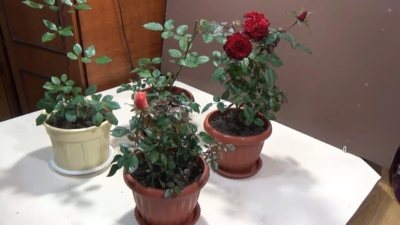

A potted rose does not like transplanting, so it is carried out only if the pot is small.
The transplant is carried out as follows:
- We choose a larger container, clean and rinse it.
- The plant has very delicate roots that are very easy to damage, so it is better to soak the flower pot for half an hour too. This will help separate the earthy ball from the pot.
- We transfer the earthen lump into a new container, sprinkle it with earth and thoroughly tamp it around the plant.
Watering the rose after transplanting is not recommended. Put it in a dark place for a week, then put it back in a lighted place.
Prevention of pests and diseases
In order to prevent infection of the flower, you need:
- Make sure that the soil is not waterlogged.
- Maintain sufficient air humidity.
- Protect the plant from drafts.
- Keep the flower out of direct sunlight.
Also, after purchasing the plant, you can treat the rose with Fitoverm, which will provide protection from pests.
Reproduction of indoor crops
A dwarf rose is propagated by cuttings. They do it as follows:
- Using a knife, which must be treated with a solution of potassium permanganate, cut a 10 cm long stalk.
- The cut should be done directly under the kidney, preferably oblique.
- Make the upper cut 5mm above the kidney.
- Remove leaves from the bottom of the cutting.
- Place the cutting in water for 10 hours.
- Plant the cuttings in a prepared mixture of sand and peat.
- Strong watering is not needed, otherwise the cuttings may rot.
- Ensure a stable temperature of at least 18 degrees and protect the cuttings from direct sunlight.
When is landing
For the timing of planting this plant, it is best to adhere to the following rules. For cold and harsh climates, spring planting is preferable. So the bushes will take root better and will be more prepared for winter. It is advisable to cut off the buds formed in the first year in order to preserve the strength for the formation of a strong root system.
If the growing region has a milder climate, planting border roses is carried out in the fall. At the same time, it is worth worrying about a reliable shelter for the bushes, because young seedlings, even of winter-hardy varieties, will be more sensitive to such conditions.
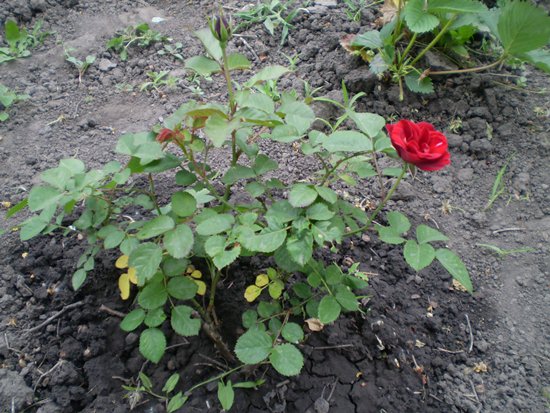

Landing at their summer cottage
When to plant curb roses
It is recommended to plant seedlings in spring, so that young plants can form a strong root system before the arrival of autumn and winter and are ready for severe cold and severe frosts. The most favorable time is mid-spring or the second half of April. The soil should warm up well by this time, and the threat of night frosts has already passed.
Choosing the perfect location
Choosing a suitable site for planting curb roses is not an easy task. Even in the summer season, they prefer to be at a temperature of + 19 ... + 22 ° С. An ideal place would be such a place where the sun would shine brightly only before 11 and after 17 hours, and the rest of the time, shadow or penumbra conditions remained on the site. At the same time, flowering crops should not be exposed to strong gusts of wind and constant drafts, from which the soil dries out, and the flowers lack moisture.
Another important condition when choosing a place is to take into account predecessors. These cannot be plants from the Rosaceae family, as they adversely affect the next planting and can leave a "legacy" of pests and spreading diseases.
What kind of soil is needed
For the full development of curb roses, high-quality soil with moderate moisture is needed, without stagnant water and not in a lowland, light in structure and with good water and air permeability.
Landing scheme and features
The size of the planting hole depends on the volume of the root part of the seedling - the hole should be slightly larger. It is recommended to pour a drainage layer about 5 cm thick at the bottom, and then on 1/3 of the nutrient substrate intended for representatives of Rosaceae. The bush is placed in the center of the hole and each root is carefully straightened. It is necessary to fill the hole to the brim so that the root collar remains 2 cm below the soil surface. It is recommended to lightly compact the soil around the seedling and moisten it abundantly. After the water has been absorbed, a 2-3 cm layer of peat mulch can be applied around each plant.
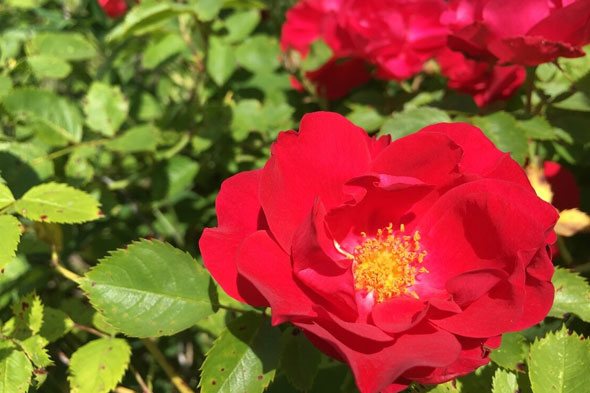

When planting several bushes, an interval between them of about 30-40 cm should be observed.
Important! In the first two weeks, young immature crops are best sheltered at night from unexpected nighttime cold snaps.
Photo
Load more photos
How to shelter them for the winter?
Many varieties of border roses are frost-resistant and winter well, but despite this, they need to be insulated in the fall.Preparation begins with the removal of dry foliage and shoots, after which a protective shelter is prepared. This is usually done with the appearance of the first night frosts. The plant is spud up no more than 20 cm high. Then pine or spruce branches are laid out around the circumference. They are pressed tightly to the ground and additionally covered with spruce branches or dry foliage. You can also make a protective frame from roofing material and film.
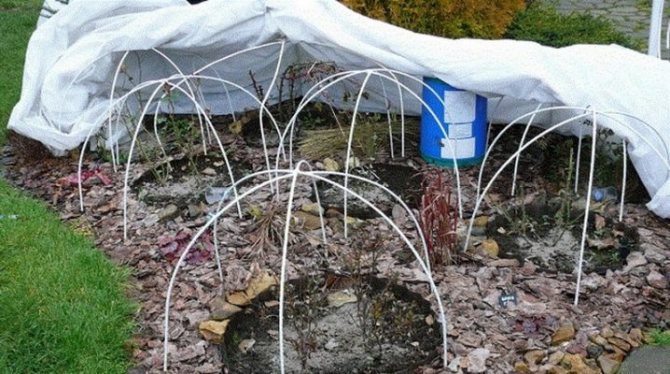

Growing a Chinese rose at home
Most often, Chinese indoor roses are grown from cuttings. In any of the summer months, the upper part of the young appendage is cut off. The resulting cuttings are treated with a growth stimulant and rooted in a pot with nutritious soil. It should be kept in a warm room (+22 - +25 degrees), with optimal humidity and no drafts.
After a month, the shoot can be considered rooted. Fertilize miniature roses every thirty days during the spring and summer. Plants can neither be overfed, nor underfeed, they need to be watered with settled water at room temperature. Do not forget to cut off the faded roses, while not the entire stem is removed, but only its upper part with a faded flower.
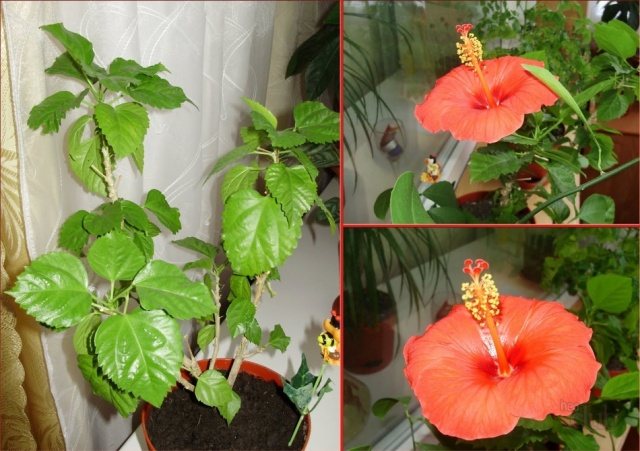

During the dormant period, the rose needs to be cut just above the bud, at this time the plant is watered little. In the place where the rose will winter, the temperature should be about +5 degrees, in February it is exposed to a slightly warmer place (up to +12 degrees). When the first leaves begin to hatch, the rose is placed in a warm and bright place.
Immediately after the rose "woke up", watered as the soil dries up, and during budding more often, alternating watering at the root with watering in the pan. In the spring, old branches need to be cut in order for new ones to grow. Some gardeners remove the first two or three buds so that later the rose blooms profusely. Yellow leaves are also removed.
The best varieties of miniature roses
There are over five thousand varieties of miniature roses. They differ in the shape and color of flowers, the size of the bush, winter hardiness and other characteristics.
Los Angeles
Rose Los Angeles is a spectacular miniature cultivar. This plant is up to 40 cm high, with shiny leaves. The color of the leaf plate is complex: brown with green veins.
The Los Angeles variety has a good bush and grows quickly. The shoots of plants are strong, they quickly become gritty. Flowers of dark orange color are 5 cm in size. The plant produces more than 80 buds. Flowering begins in June and lasts until September. Los Angeles is suitable for outdoor planting or growing at home.
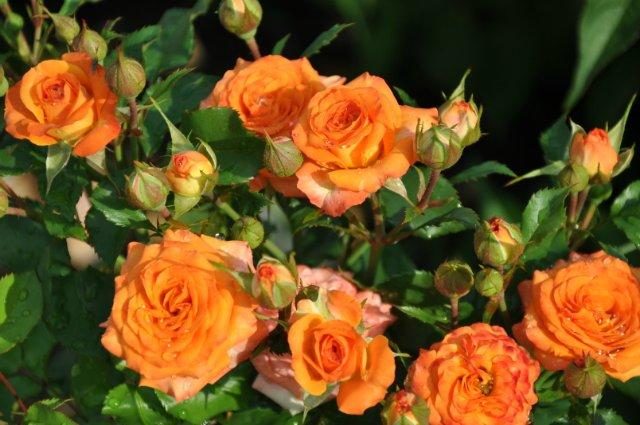

Clementine
Miniature rose Clementine was bred in 1997 in the famous Tantatau nursery. The bush is 0.5 m high, grows up to 0.4 m wide. The shoots of the plant are strong and strong, do not require support. The leaves are dark green with a glossy surface.
The Clementine variety produces numerous flowers with a diameter of 4 - 5 cm. The color of the petals is orange, lighter at the edges. The aroma is weak. Flowering is plentiful, lasts the whole season. The hydride is resistant to black spot and powdery mildew. The winter hardiness of the bushes is high, the plant tolerates a decrease in temperature to -23 ° C.
Advice! To grow a miniature rose at home, choose wide containers made of clay, wood, plastic, metal.
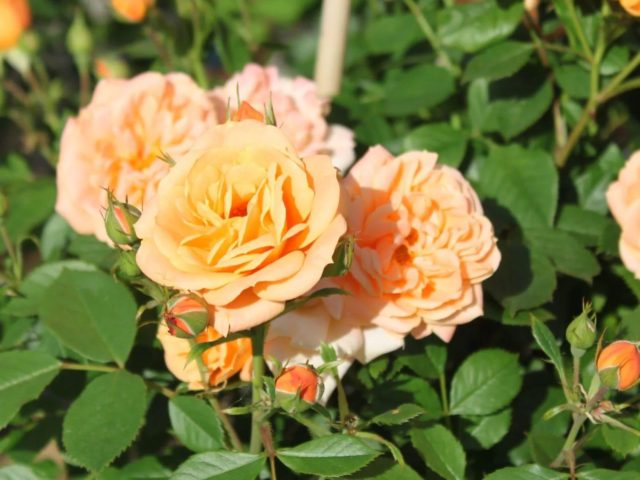

Jewel
Rose Jewel is a representative of miniature hybrids. The bush is strong, but compact at the same time. Its height is 25 - 40 cm, the width of the plant reaches 30 cm. Its leaves are dark green, glossy and dense. The winter hardiness of the plant is -23 ° C.
Jewel begins to bloom in June. The buds bloom continuously, until the onset of cold weather. They are collected in 3 - 7 pieces in a brush, rarely single flowers appear. Petals of an unusual lavender color with a shade of lilac. Flowers are densely double, 2 - 3 cm in size. Their aroma is poorly expressed.
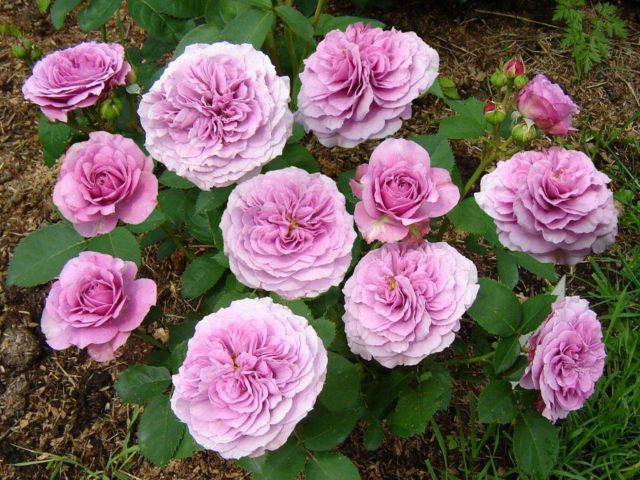

Curlers
Miniature rose Curlers bred in 2000 in France. The cultivar is prized for its unusual petals with red and yellow stripes. The flowers are large, terry, up to 5 cm in size.Each bud consists of 20 to 25 petals. Flowers, collected in clusters of 6 - 15 pieces, have a light, barely noticeable aroma.
The bush is compact. Its height does not exceed 30 cm. The foliage is dense, small, with a glossy surface. The flowering period is continuous, beginning in summer and continuing until autumn. The miniature bush looks good when decorating borders.
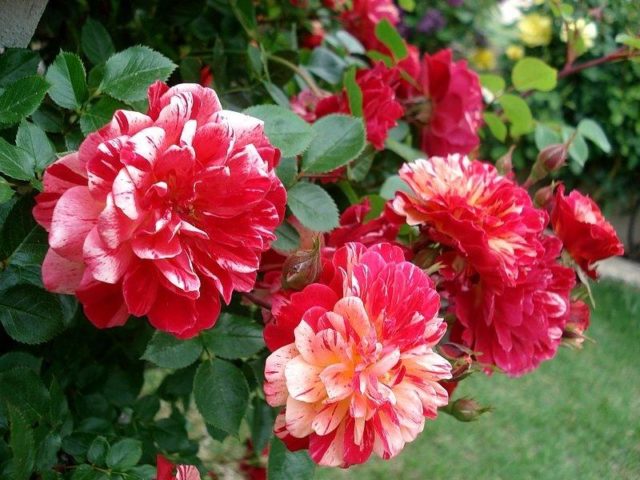

Cinderella
Rose Cinderella was bred in Germany in 2003. The hybrid has received many awards at international exhibitions. It is a miniature bush 30 cm high. Its shoots are erect, smooth, and do not have thorns. Cinderella has a strong aroma typical of a rose. The flowering of the culture is continuous throughout the season. Resistance to fungal diseases is high.
Numerous pale pink flowers are formed on the bushes. Their color depends on the weather conditions. When the buds are just opening, the petals are pink. When exposed to the sun, they turn white. Flowers are densely double, 3 cm in diameter, consist of 100 or more petals. The buds are collected in brushes of 5 - 20 pieces.
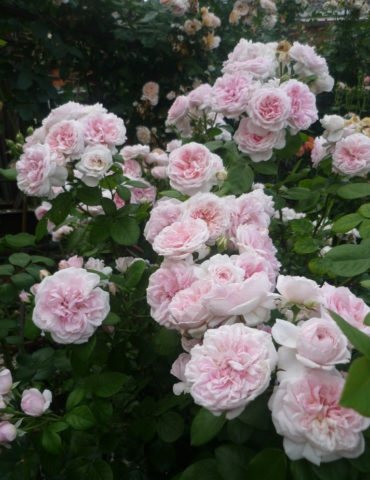

Pur Tua
The Pur Tua variety is distinguished by its compact size and decorative effect. The hybrid was launched in France in 1946. The bush is up to 25 cm high. The shoots are erect, covered with dark green shiny leaves. Pur Tua looks perfect in pot culture and when decorating borders. Flowering begins in June and lasts until autumn.
In summer, the bush is completely covered with snow-white flowers. Unopened buds of a beautiful elongated shape, cream color. The blossoming flowers are white, semi-double, with a beige undertone. The size of the inflorescences is 3.5 - 4 cm. The aroma is pronounced during flowering.
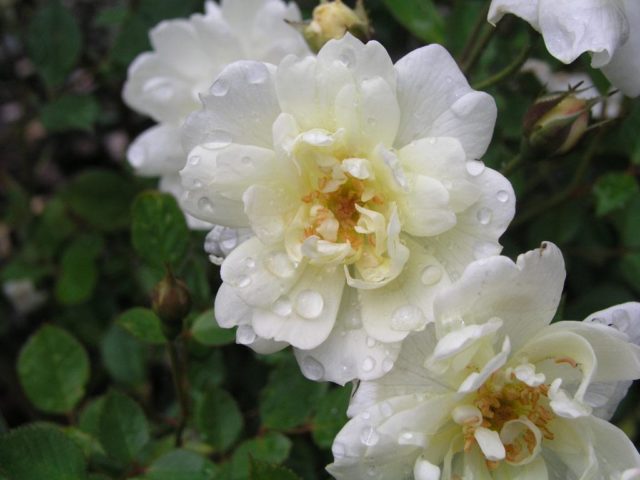

Hummingbird
Miniature hybrid Hummingbird was obtained in 1958 in France. The bushes are slightly spreading and thickened, up to 35 cm high. The leaves are shiny, leathery, dark green. Shoots are red-brown.
The hummingbird rose has an unusual color. The flowers are bowl-shaped, densely double, and consist of 20 - 25 petals. The color of the petals is apricot. Flowering is abundant and extended. Flowers up to 4 cm in size are formed in clusters of 3 - 5 pieces. The aroma is pleasant, tea-like.
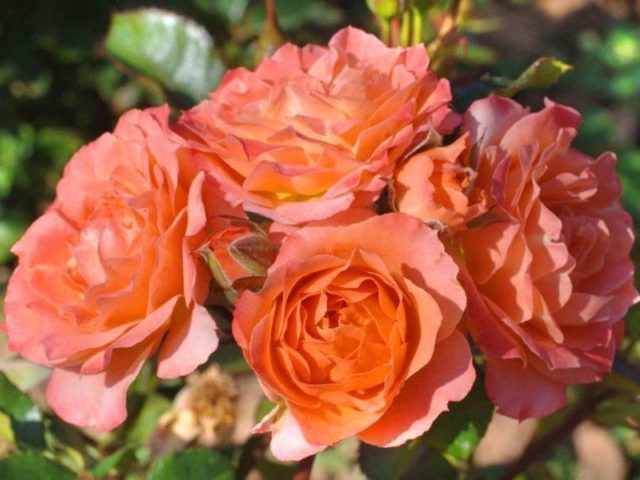

Pixie
The Pixie variety was obtained in 1940 in the Netherlands. A miniature rose grows up to 40 cm in height and up to 60 cm in width. Its stems are thin, practically without thorns. Pixie is valued for its decorative appearance, frost resistance, immunity to diseases.
The flowers of the rose are densely double, ranging in size from 2 to 4 cm. Each bud contains about 50 petals. Their color is white, with a slight pink undertone. Flowering is intense and lasts all summer long. The inflorescences have a weak aroma.
Important! The Pixie variety winters well in the gardens of the Moscow region, central lane and most of Russia.
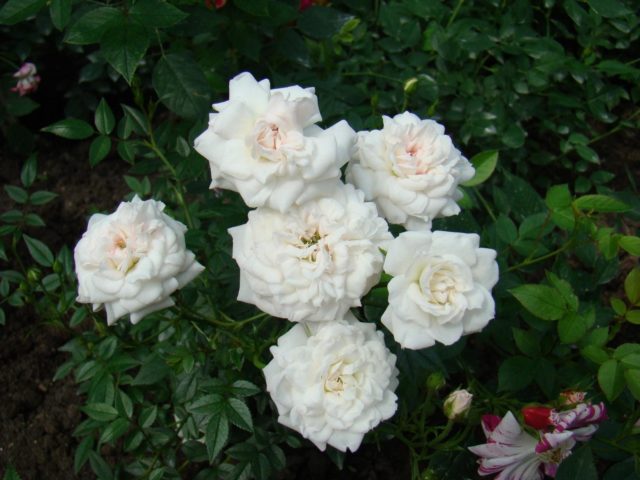

Garnet bracelet
Rose Garnet Bracelet is a miniature variety of domestic selection. The bush reaches a height of 40 - 50 cm, the girth is 50 cm. The plant is spreading, with dark green shiny leaves. Rose rarely gets sick due to its high immunity to powdery mildew and black spot.
The bush produces dense and large classic-shaped flowers with a diameter of 4 - 5 cm. The flower petals are red, on the back side - white. The inflorescences consist of 5 - 7 buds. Garnet Bracelet is resistant to sunlight, does not fade in drought.
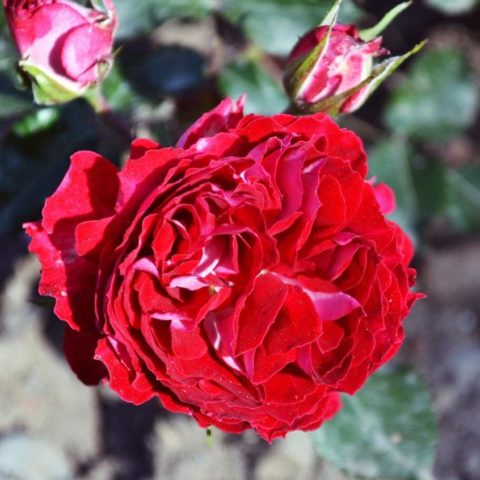

Finger Boy
Rose Boy-with-Finger was bred by domestic breeders in 2008. The plant has compact dimensions, its height does not exceed 40 cm. Shoots are covered with small, elongated, dark green leaves.
The flowers of the Boy-s-Finger variety are 4 cm, cup-shaped, semi-double. Pinkish-salmon color, they are located in inflorescences of 3 - 100 pieces. The aroma is weak. Flowering is continuous, until the autumn cold. Resistance to diseases is average, preventive treatments are required.
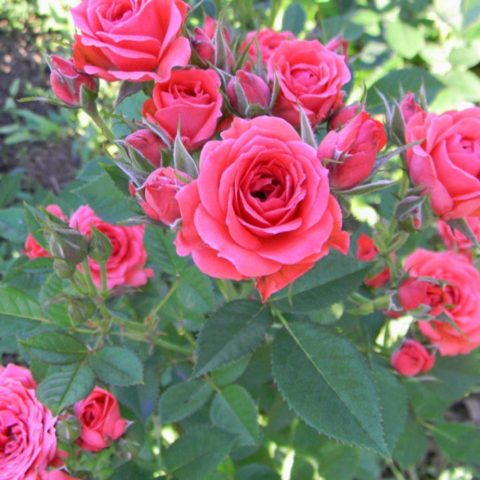

Baby Bunting
Miniature variety Baby Banting was obtained in 1953 in Holland. A loose and spreading bush up to 35 cm high. Its leaves are oval, glossy, leathery, dark green in color.Flowering is long and continuous. The hybrid is resistant to black spot and powdery mildew.
Rose Baby Bunting produces numerous semi-double flowers 3 - 4.5 cm in size. Its inflorescences are large and lush, consisting of 70 - 80 buds. The petals are pink-red. Their machine gun is lightweight, barely noticeable.
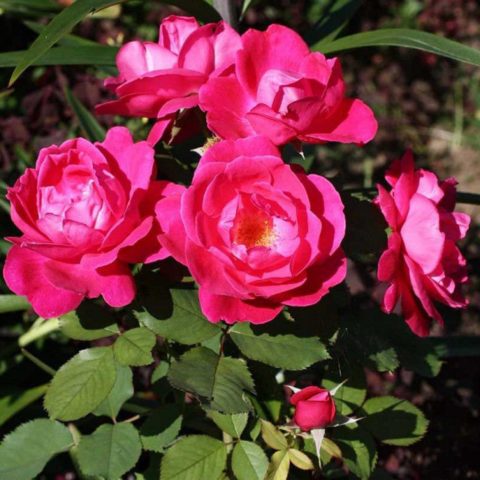

Maidi
Miniature rose Maidi was bred in Germany in 1984. The bush is 0.4 m high, resistant to diseases and winter cold. The plant is compact, takes up little space on the site. The leaves are small, numerous, dark green.
In June, the Maidi rose is covered with bright red flowers. On the reverse side, the petals are silvery white. The buds are located in inflorescences. Blooming flowers 4 - 5 cm in size have a light, pleasant, barely noticeable aroma.
Advice! Pruning old, dry and broken shoots helps to stimulate the abundant flowering of the rose.
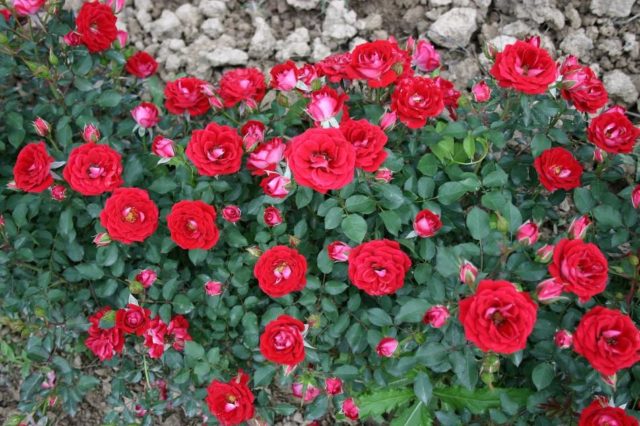

Lavender Meillandina
Rose Lavender Meillandina stands out with flowers of a delicate lilac color. Plant height 50 cm, width - 40 cm. Shoots are light green, do not have thorns. The leaves are small, green, semi-glossy.
Flowers with a diameter of 4 - 5 cm, densely double, with a light aroma. The buds are collected in inflorescences of 2 - 5 pieces. Miniature hybrid Lavender Meillandin resistant to diseases and winter cold.
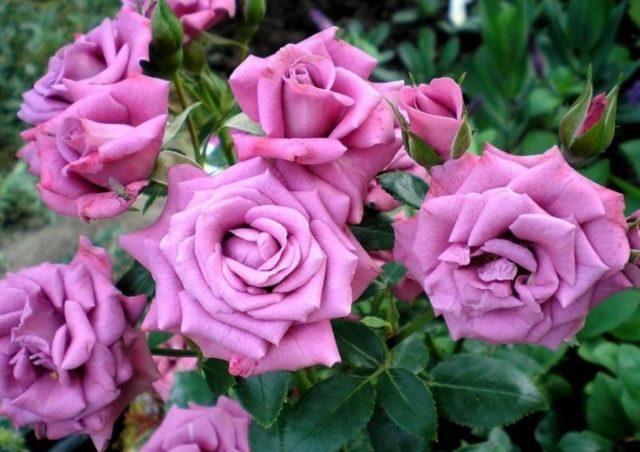

Fresh Pink
Miniature rose Fresh Pink is a compact plant no more than 35 cm high. At the same time, the bush is branched and dense, from the beginning of summer it is covered with large double flowers. It grows in one place for 10 years or more.
Flowers 7 - 8 cm in size are formed in clusters of 3 - 5 pieces. The color of the petal is pink, darker at the edges. Medium intensity aroma. Flowering is continuous even when Fresh Pink is planted in partial shade.
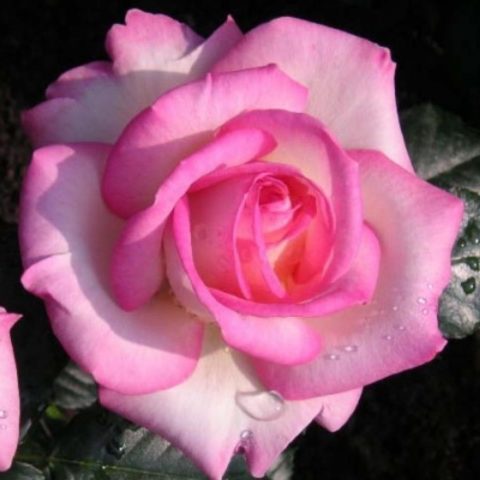

Danielle
Miniature hybrid Danielle grows up to 30 cm in width and height. Its leaves are juicy green, dense, small. In June, buds bloom, which form flowers 3 cm in size. They consist of 50 - 60 petals. The aroma is delicate, pleasant. Inflorescences consist of 15 - 20 buds. The color is complex, from white to apricot tones.
